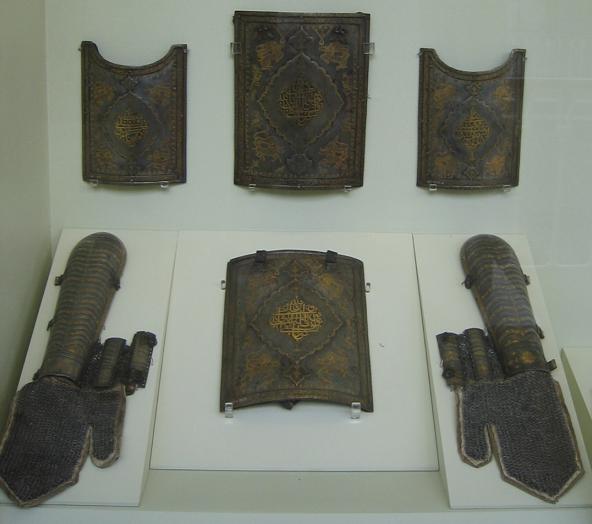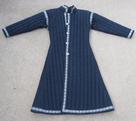Subject: irregular armored cavalryman
Culture: Turco-Iranian
Setting: civil war, Zand-Qajar Persia mid-late 18thc
Object: armor
Helmet
* Persian arms and armour 2000 p69
"[Persian helmets from the second half of the 18th century and the 19th century] have spherical domes with sharp tufts and two sleeves for holding feathers. Sometimes, instead of a fluke, an additional barrel would be mounted on top. The nose was protected by a moveable nose protector and there was a long steel mail aventail, partially covering the arms attached to the helmet. The helmets were usually richly decorated by gold or silver damascening and engraving. In more inferior, later helmets the decorating was executed by etching with acid. The dome was sometimes shaped like a bird's or demon's head with horns."
* Robinson 1967 p40-41
"[The Persian helmet in its later form] is fitted with a curved nasal of square section with foliate terminals, which passes through a socket on the brow part of the bowl fitted with a set-screw for securing it in the raised or lowered position. When lowered, the bottom finial would come to below the level of the wearer's chin, so giving reasonable protection against a sweeping cut with a sword. ... [The front of the aventail] acts as a screen for the eyes and may, in fact, have covered them in many cases, for they are deep enough for this purpose."
* Wilkinson 2011 p52
"Helmets of this type [kula-khud with horns and a rudimentary face] were primarily ceremonial and never intended for serious use but they form an interesting group. Similar helmets made for battle are usually much plainer and simpler in design ...."
* Pitt Rivers Museum online > Helmet (1966.1.1359)
"This early 19th century Persian helmet depicts the face of a pre-Islamic demon or Div. In the myths recorded by the author Ferdowsi in his 10th century work Shahnameh, the great Persian hero Rostam must complete seven labours in order to rescue his king Key Kayus, held captive by the Divs (demons) of Mazandaran. The final of these labours is the location and slaying of Div-e-Sepid (the White Demon), who is king of all the Divs. As Herakles (known as Hercules to the Romans) wore the skin of the Nemean Lion after he had killed it, so Rostam wore the face of Div-e-Sepid on his helmet. As such, this helmet symbolically suggests that the owner possessed the heroic and awe-inspiring qualities of Rostam, much as lion-like helmets in later centuries spoke to Europeans of the qualities of Herakles."
Plates
* Elgood 2004 p238
"Chahār-ā'inā/Chār-Ainā (Persian, literally 'four mirrors') Steingass gives āyina as 'a mirror, sometimes made of polished steel'. Four metal plates, generally worn over a suit of mail, to protect the ribs. General Indo-Persian usage and Far East. Russian armour of this kind is called zertsalo meaning mirror.
* Persian arms and armour 2000 p68
"A typical chahar-a'na would consist of four rectangular steel plates; one for the chest, one for the back and two for the sides, with semicircular excisions on the top that fit into the armpits. The plates were held together by leather straps and a coat of mail was worn underneath."
Coat
* Elgood 2004 p242
"Chilta (Persian) Thick double coat for soldiers. ... Chihal'tah. 'Fourty-fold coat'. A fabric coat of many layers worn as a defence by soldiers. ... Chihilqad, a quilted coat of cotton or velvet worn over armour, referred to as chihal-qad and chahlam, both 'a sort of armour.' Chihal means forty." [references omitted]
* Elgood 2003 p250
"Kawaj (Persian) Quilted jacket worn in battle." [reference omitted]

